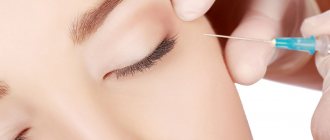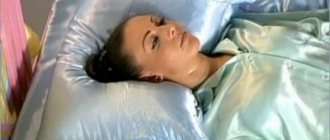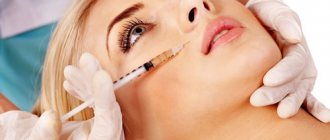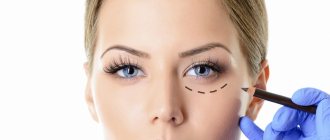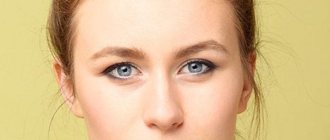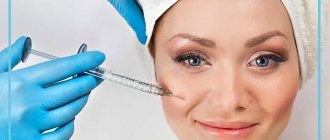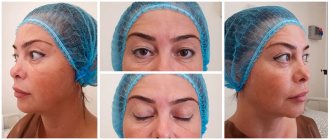Effect of Botox on eyelids
The skin in the eye area is thin and delicate, so it is more susceptible to age-related changes than other areas of the face. In girls with active facial expressions, “crow’s feet” (facial wrinkles in the area of the outer corners of the eyes) appear at the age of 25 or earlier.
Signs of age on the face occur when blood circulation deteriorates, the structure of the dermis and muscle function change. The skin becomes less collagen, elastin, some fats, and water, which is why it loses strength and elasticity and begins to sag. And the muscles become overstrained from constant work. In the case of the eyelids, the orbicularis muscle, which is responsible for opening and closing the eyes, experiences a lot of stress.
How does this affect your appearance? Grooves and folds appear around the eyes. The upper eyelid droops (ptosis).
Combating these signs of aging is one of the most popular uses of Botox. How does it work?
Botox is a medical drug that contains the strongest poison botulinum toxin. It blocks the transmission of nerve impulses to the muscle, causing it to become paralyzed. The muscle stops contracting and stretching the dermis. The configuration of the muscular system and the vector of skin tension change. The drug is injected into the muscle through injection.
For what purposes is Botox done on the eyelids:
- smoothing out wrinkles,
- raising the upper eyelid and lowering the lower eyelid, opening the gaze,
- correction of eye opening asymmetry,
- raising eyebrows.
This article does not cover the medical uses of Botox used to treat strabismus, eye tics, and other uncontrollable muscle spasms and eye disorders.
Indications and contraindications
Brow lift with Botox is performed when there are external signs of age-related changes, which are characterized by drooping eyebrow lines and their asymmetry. The injections used are effective for eliminating wrinkles between the eyebrows (read more about the use of Botox for the area between the eyebrows and forehead here). As a result of the procedure, changes in the shape of the eyebrows and their elevation are observed.
But this procedure is not so harmless, so it has certain contraindications:
- hemophilia is a disease in which blood clotting is impaired;
- skin diseases;
- benign and malignant tumors;
- chronic pathologies;
- infectious diseases;
- epileptic seizures.
Botox injections cannot be performed if there are skin problems in the areas where the neurotoxin will be injected. Girls who have moles in this area will also have to refuse the procedure.
Efficiency
The effect of Botox lasts, on average, 1-5 months. Then the result disappears. Manufacturers of some drugs containing botulinum toxin claim 9 months as the maximum duration of effect, but in practice this does not happen. In some cases, Botox does not produce any results.
Remember! Botox does not solve the problem of age-related changes in the eyelids, but only creates temporary appearance. You have to pay for a fleeting illusion with health and beauty. Botox disfigures the face, is toxic to the body and - attention! – accelerates the aging process. It is a poison that only causes harm.
We prove what cosmetologists are silent about or mention in passing as something incidental and insignificant.
Pros and cons of Botox for eyelids
The only advantage of Botox for the eyelids is the short-term effect of smoothed wrinkles and lifted skin, which, by the way, very often does not suit women. And such a result is definitely not worth the retribution that sooner or later will overtake everyone after botulinum toxin injections. And most often you don’t have to wait long.
So, what are the disadvantages of eyelid Botox for health, beauty and youth?
Harm to health
After Botox injections, your health often worsens: headache, injection zones. Fever, vomiting, dizziness and other health problems also occur.
It has been proven that muscles affected by botulinum toxin do not fully recover. Moreover, botulinum venom acts not only on the target muscle, but also spreads beyond the injection area. This often causes various complications to the eyes and puts the entire body at risk (details in the next chapter).
Do not forget that this is a neurotoxin, that is, it paralyzes neuromuscular activity. Just imagine that after Botox injections this poison can end up in any part of the body!
Harm to beauty
Even if you are very superficially familiar with the topic of Botox, you probably know how destructive it is for facial expressions and appearance in general. Remember the faces of the victims of botulinum therapy! Immobilized, waxy, shiny, devoid of life and attractive facial features. Faces that cannot laugh, be surprised, or frown.
It’s even worse when the emotion expressed is the opposite of the emotion experienced. Have you ever seen how a lady with a half-numb face tries to smile, and the corners of her lips treacherously stretch down, and it seems to others that she is expressing disgust? Botox!
Moreover, the Botox procedure for the eyelids is accompanied by an infinite number of side effects that disfigure the woman. And these are not exceptions, but common practice. Bruises or hematomas almost always occur because the needle damages the capillaries. The eyes often swell and new wrinkles appear. Sometimes Botox not only does not lift the upper eyelid, but provokes severe ptosis up to the complete inability to open the eyes.
Harm to youth
It’s not generally customary to talk about this, but Botox accelerates aging. This can be understood from the reviews of women who discover, a few days after the injections, new wrinkles and sagging that were not there before the procedure. And there is a scientific basis for this.
When one or more muscles are paralyzed, the muscular system is forced to rebuild its work. The muscles located next to the immobilized one begin to perform, in addition to their own, other functions that are not inherent in nature. Healthy muscle tone is disrupted and spasms occur. In areas adjacent to the treated area, the skin begins to stretch more strongly. And here they are, new age-related changes!
Side effects of Botox eyelids
Neurologists are wary of Botox because its long-term effects have not yet been studied.
But there are known side effects that commonly occur after Botox injections. The most common eye areas treated with poison are:
- Bruises, extensive ugly hematomas.
They arise due to damage to blood vessels during injections. - Dryness and feeling of sand in the eyes.
- Pain when touching the eyes.
- Tight skin.
- Ptosis of the upper eyelid, inability to open the eye.
The reasons for this complication are the uneven distribution of botulinum poison and its release beyond the target muscle. - Eyebrow drooping.
The reason is the same. - Severe, ugly swelling.
Due to impaired muscle tone, lymph flow suffers, which causes swelling. - Asymmetrical features.
One eyebrow may have a normal shape, while the other may droop or rise. The shape of the eyes may become distorted. And so on. - Allergy.
Up to angioedema and anaphylactic shock. - Diseases of the organs of vision.
Since botulinum toxin spreads beyond its target, it can cause complications: double vision (diplopia), - paralysis of the eye muscles,
- anisocoria of the pupils (different sizes),
- mydriasis (pupil dilation),
- strabismus,
- blindness.
And if after the first Botox injection such consequences already occur, imagine what will happen next! After all, it won’t be limited to one visit to a cosmetologist. In a month or two, the wrinkles will return and new signs of aging will appear. The procedure is allowed to be done once every three months. Just imagine: poisoning yourself every season!
But the body will begin to get used to botulinum toxin, its effect will begin to weaken. You will have to go to the cosmetologist for a new portion of poison almost as often as for a manicure. And the doses will increase. Physical and psychological dependence will become so strong that it will be almost impossible to get off the needle. The face will acquire ugly features, and Botox correction will not correct anything.
Treatment options
There are many ways to fix a problem. They are used depending on the severity of ptosis. Home methods are available to everyone and do not require large expenses. However, you will have to wait longer for the result than in other cases. Physiotherapy and various injections are usually prescribed in combination to more effectively and quickly solve the problem. If they fail, then in extreme cases doctors recommend resorting to surgery.
Home methods
To make the drooping of the eyebrows go faster, you need warmth. You can act locally - applying a hot compress to the eyebrow, while covering the forehead area. Or you can go to the bathhouse or sauna and steam yourself properly. But with the warming method, caution is in order. If ptosis is caused by swelling, then this can worsen the problem, and the swelling will descend to the area of the bridge of the nose and cheekbones.
Self-massage helps a lot. It must be done daily. The following organic oils are well suited for these purposes:
- shi;
- coconut;
- jojoba;
- shea butter
Gently treat the injection area, moving strictly along the massage lines.
Medications
Injections of drugs such as:
- "Neuromidin";
- "Prozerin";
- "Neuromultivitis".
Apraclonidine eye drops can cause muscle spasm, thereby lifting it. In the complex treatment of ptosis, mesotherapy cocktails are also used to saturate the tissues with vitamins - with their help, recovery occurs faster.
Additional injections
For minor problems, doctors sometimes prescribe repeated Botox injections. They are made into fibers that lower the eyelid, balancing the strength of the antagonist muscles. The second option is to inject the toxin around the other eye so that the eyebrow above it also droops slightly.
As a result, symmetry will appear and ptosis will not be so noticeable.
Physiotherapy
In case of damage to the oculomotor nerve, physiotherapeutic methods are resorted to. The following procedures are assigned to correct the problem:
- ultra-high frequency therapy;
- paraffin therapy;
- laser;
- electrophoresis;
- galvanic currents.
❤
What drugs are used for Botox?
Initially, Botox was the name of the first drug containing botulinum toxin, although now this is the name of the entire category of drugs containing this poison. The Botox brand was released about 30 years ago by Allergan from the USA.
Following this, competing brands began to emerge in different countries. The main competitor of Botox is Dysport, produced in France. The most expensive drug is the German Xeomin. A cheap Chinese analogue of Botox is Lantox. The most active country in the “youth injections” market is South Korea, which has released Botulax (almost exactly the same as Botox), Neuronox, Meditoxin, and Heutox. This trend was not lost on Russia either, which presented its Relatox about six years ago.
All drugs have the same active ingredient - botulinum toxin type A (BTA), once developed as a bacteriological weapon. The products differ in production technology, dosage, particle size, composition of excipients, strength and duration of action, sensations during and after the procedure, and so on.
What nuances in the compositions do you need to know about?
First, molecular weight matters. The smaller the particle size, the more evenly the drug is distributed throughout the muscle, but at the same time it more actively goes beyond the target, that is, it creates the threat of complications. Botox has a large molecular weight (relative to some other drugs). Dysport has almost two times lower. The smallest is that of the German Xeomin and the Russian Relatox (six times lower than Botox).
Secondly, it is worth paying attention to the presence of stabilizers in the composition that inhibit the botulinum toxin molecule. With them, it acts more softly and does not spread so actively beyond the target target. In Botox it is albumin (human immunoglobulin) and sodium chloride. Albumin is also found in Dysport (in smaller quantities), Xeomin (in larger quantities), and Botulax. Relatox doesn't have it. Instead of albumin, Lantox contains gelatin of animal origin
Thirdly, the quality and degree of purification of BTA matters. It is believed that Xeomin has the highest price, which is why it is more expensive.
The concentration of BTA in the drugs is also different, which affects the dosage. If you need 10-20 units of Botox for crow's feet, then 30-60 units of Dysport.
Botox has average strength and duration of action. Dysport is more powerful. Xeomin is softer. Relatox begins to act faster and the effect lasts longer.
Description of the procedure
The Botox procedure for the area around the eyes takes 20-30 minutes.
First, the cosmetologist marks the injection sites with a marker. To identify problem areas, the patient smiles, frowns, and so on.
As a rule, injections are given at four points near each eye: two near the outer corner of the eyes and one near the tip of the eyebrow and in the area of the bone border.
After the injections, wait 10 minutes.
Typically, the effect appears on days 3-7 and reaches its maximum after two weeks.
What does it look like?
The drooping of the eyebrows after the injection looks like an influx of skin onto the ciliated edge, resulting in the formation of folds. Also, the eyelid may become filled with swelling and swelling of the skin . This is especially noticeable when it appears asymmetrically; in addition, bags can form under the eyes. Swelling and redness may occur at the injection site.
Photo
And here’s what drooping eyebrows look like in the photo.
Cost of eyelid botox procedure
To treat crow's feet with Botox, it takes 10-15 units of the drug on one side. About 5 more units are needed to raise the eyebrow and then the eyelid. In total, Botox for two zones (near the left and right eyes) requires 30-40 units per procedure.
This will cost, on average, 2 thousand rubles. But this is the price only for the drug. Another additional 500-2000 rubles for a consultation with a cosmetologist.
Often, after the first procedure, correction is required two weeks later, and this is additional poison and expense. As you get used to the drug and signs of age increase, the dosage increases.
Choosing a cosmetology salon
A color photo of eyebrow dysport can be viewed in the Moscow salon “OB clinic”. Here the visitor will also be offered to undergo any of the available procedures using modern high-tech equipment. The cost of services from qualified specialists remains low. In addition to this, the administration of the institution offers discounts on any procedure up to 30%. Here you can raise your eyebrows with Dysport at any time. Contraindications are minimal.
An innovative technique for skin rejuvenation using drugs based on botulinum toxin has long become a popular cosmetic procedure. Without these methods, it is difficult to correct skin defects. Surgical plastic surgery causes serious concerns for many women, so not everyone agrees to such procedures. They believe that it is better to raise eyebrows with Dysport than with a scalpel.
Opinion of cosmetologists
The official position of cosmetologists is on the side of Botox, since it is a commercially profitable procedure. They do not talk about muscle paralysis and forced restructuring of the muscular system, but call this process the harmless word “relaxation.” And Botox in their language is not a neurotoxin, but a muscle relaxant. The aggressive image of the deadly botulinum toxin is smoothed over by the thesis that it is used in micro and nano doses.
But in confidential conversations, cosmetologists say completely different things. Many of them do not inject themselves with Botox, and this is not without reason. Read professional forums where cosmetologists communicate with each other. There is a lot of useful information about how botulinum poison acts on the body, how patients get hooked on the needle, and what the consequences are.
Many are sounding the alarm that there are very few experienced cosmetologists in the industry. Dosages, administration techniques, and storage periods are often violated. The drug is diluted incorrectly and the injection site is missed. Low-quality, expired materials, etc. are used.
You can also talk to neurosurgeons. Many faces, distorted after Botox, pass through their hands.
Order of conduct
Before injecting Botox into the area between the eyebrows, you first need to consult a doctor.
He will be able to determine the amount of the drug and give some instructions. In addition, the specialist must find out the individual characteristics of the body and possible contraindications. The information obtained will allow you to understand the type of drug that will be used for manipulation. Next, the doctor draws up a plan for future lifting. At this stage, you need to understand the type of agent being administered, and also find out what substances should be used for disinfection and pain relief. Only after all these measures have been completed, the specialist can set a date for the operation. Girls should stop taking antibiotics before getting Botox injections.
How many units of the drug should I take?
The dosage of the drug for the procedure is determined taking into account the following factors:
- features of facial structure;
- reasons for correction;
- severity of muscle hyperfunction.
To correct eyebrows, 5-10 units of the drug are used.
Where to inject?
It is necessary to inject Botox into the muscle tissue of the eyebrows . Cooling therapy is used to relieve pain. To raise the eyebrow line, an injection is performed in the upper region of the orbicularis oculi muscle or in the center of the frontal muscle. To obtain maximum results, pinpoint precision is required in hitting the syringe needle.
How is botulinum toxin administered?
On the day appointed for lifting, the doctor first cleanses the face. After this, he uses a marker to indicate the places that need correction, and then follows the following procedure:
- Disinfects the skin of the face.
- The injection sites are cooled to reduce pain and treated with an antiseptic.
- Injects the drug using a syringe with a thin needle.
- After administration of the drug, the skin is disinfected again.
On average, the procedure takes about 15 minutes and does not cause much discomfort to the woman.
Patient reviews
Those who have had Botox done to the eye area write that:
- no effect
- a frozen surprised look appears,
- injection sites become numb,
- eyelids become very swollen for several months,
- the eyes stop opening completely or partially,
- the face swells, the skin collapses when touched,
- the upper eyelid droops,
- new wrinkles appear.
Quote from a patient who had Botox done in the eye area:
“I can’t open my eyes and I have no idea when this horror will return to normal.”
The review was updated 7 months after the procedure:
“The drooping eye remained unchanged. After consultation with a neurologist, neuropathologist, after a total examination by an ophthalmologist, an MRI of the brain and facial nerve, and an appointment with a leading neurosurgeon, the unequivocal verdict is Botox’s FAULT!”
Swelling of the eyelids after Botox
After Botox, the eyelids often swell to the point of being ugly. Swelling can last for several days or weeks, or it can become a chronic problem.
Quote from a patient who had Botox on her eyelids:
“Every morning for 3 months now I have been getting up with swollen eyelids, although in a normal, Botox-free life I am not prone to them from the word “at all.”
Summarize
Eyebrow Botox: before and after
Eyebrow Botox is a procedure that is performed in three stages: cleansing the skin and hairs, degreasing and applying a special composition. Then the product is removed with a cotton pad. After this, it is recommended not to wet your eyebrows for 24 hours and protect them from exposure to ultraviolet rays. The use of alcohol-containing cosmetics should be completely avoided, as they negatively affect the hair.
The benefits of Botox for hair are:
- the ability to improve hair quality;
- growth stimulation;
- strengthening, straightening;
- hairs will be more manageable;
- eyebrow styling will be easier.
It is important to understand that after Botox the hairs will not stay combed up, since this effect can be achieved by lamination (it is the last third component that secures them in this position). Botox will improve their quality from the inside, and this in turn will make styling easier, because they will be full and strong.
Share with your friends!
more
Read us in the Zen channel
Eyelids drooping after Botox: what to do
First, let us remind you that one of the stated goals of Botox is to lift the eyelids. This alone is doubtful. Many talk about the ineffectiveness of the fight against ptosis with Botox and confirm this with photographs taken 2-3 weeks after the procedure. They show that the eyelids did not rise at all, but continued to hang over the eye, as before.
Moreover, after Botox injections, the problem of the impending eyelid may intensify or appear if it did not exist before. This complication is especially often accompanied by forehead Botox. What's happening? The frontalis muscle becomes immobilized under the influence of botulinum poison, and stops contracting and holding what it previously held. The eyebrows fall over the eyes and pull the eyelids down.
To get rid of swelling, drooping eyelids and other complications after Botox, you need to speed up the removal of the toxin from the body. To do this, we recommend doing everything that improves blood circulation and lymph flow and speeds up metabolism. These are physical exercises, self-massage of the face (can be done no earlier than two weeks later, otherwise the effect of the poison will increase), exposure to high temperatures (baths, saunas). The body also needs a lot of water.
Preparing for eyebrow botox
In order for the Botox procedure to be successful, it is important to prepare for it in a certain way.
Preparation rules:
- prohibition of drinking alcoholic beverages and smoking a week before exposure;
- stopping taking any medications that may affect the rate of blood clotting;
- ban on injections during menstruation;
- Before exposure, it is advisable to drink a cup of coffee or tea.
Read also: The eyebrow above the eye is swollen, what to do?
Before the start of manipulations, the cosmetologist must explain to the patient the specifics of the procedure, explain the effect that is planned to be achieved, as well as the specifics of care during the rehabilitation period.
How to get rid of wrinkles and lift eyelids without Botox
The surest way to transform the eye area is a properly selected set of exercises. MelAnnett has been developing a program for natural rejuvenation of the body for several years and testing it in practice. As a result, the “Basic Marathon” was created. This is a set of exercises that straightens the back, relieves muscle tension, improves blood supply and lymphatic drainage, that is, it solves the main problems that provoke age-related changes. At the end of the marathon, each wrinkle is polished separately.
Among other results, MelAnnett's Basic Marathon helps eliminate crow's feet and lift eyelids.
If you've already had Botox and are unhappy with the effect, don't let yourself down! Get started on your recovery by taking part in the Basic Marathon!
